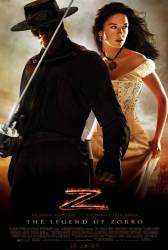Revealing mistake: During the shoot out with McGivens's gang at the Cortez ranch, the wife of Cortez sneaks out of the trap door with her baby and peers around the side of the building. You can notice that the baby is really a doll.
Factual error: This movie takes place in 1850, but the "Confederate States" and "Confederate army" are mentioned. There was tension between "free" and "slave" states in 1850, but the American civil war was 11 years in the future.
Factual error: One of the lamps during the party scene has a light bulb.
Factual error: In the first scene, McGivens appears and demonstrates the new repeating rifle, and even mentions that it is a Henry Repeater. This brand of rifle was not invented until the late 1850s, almost a decade after the events depicted in this movie.
Continuity mistake: In the scene when the man on the horse tries to get the case, you can plainly see that his scar changes from dark to bright red and then back again.
Other mistake: In the ending before McGivens gets ready to slit Zorro's throat, Zorro kicks McGivens 4 times. After McGivens goes forward on his face, the rope that held Zorro's hands tied is gone, nor are there pieces left behind from him cutting them.
Revealing mistake: In the burning barn, watch closely when Zorro goes to jump on the horse. There's a low angle shot of his feet running up to the horse, and a piece of burning wood lands in the foreground. The fire on top of the burning wood is burning upwards like normal fire. However, the fire on the side of the board is somehow burning upside-down, with the fire moving downwards. Seems to be a slip-up in the digitally-added fire effect. It goes by quick, so slow-motion helps, but is not required.
Revealing mistake: Watch closely when Zorro's horse bursts into the burning barn. The visual effect is comical. It, along with some debris in the air, simply appears between frames in an unrealistic way.
Other mistake: Toward the end where Zorro is trying to catch the wine bottle that he tied to the train to explode, the wine bottle goes from being completely underneath the train to being tied on the outside in plain view and back again.
Continuity mistake: After the train explodes at the end, you see a closeup of Zorro and Elena behind a small stone wall. Zorro is covering Elena, and his head is to her left and he has his hand against the wall. However, when the camera cuts to a wideshot, suddenly his head is to her right and his hand is no longer on the wall.
Factual error: Clothes hangers were first invented in 1860, 10 years after the movie takes place. A scene in the market place features those hangers.
Factual error: The locomotive pulling the train carrying the nitroglycerin has a 2-6-0 wheel arrangement. The earliest 2-6-0 was built in 1853, 3 years after the film is set, and had their leading axles mounted directly and rigidly on the frame of the locomotive, rather than on a separate pivoting truck as the engine in the film has. The engine overall more closely resembles an 1880's vintage engine than an 1840's engine.
Deliberate mistake: In the beginning of the film, the horse-drawn carriage driven by McGivens is able to crash through a brick pillar and keep moving forward... yet just one minute later in the scene, it's flipped and destroyed by a rope attached to a flimsy wooden spool. There's no consistency to the strength of the carriage.






Chosen answer: If I remember correctly, he took the name from Diego de la Vega in the first film, when Diego passed the Zorro identity on to him.
Cubs Fan ★